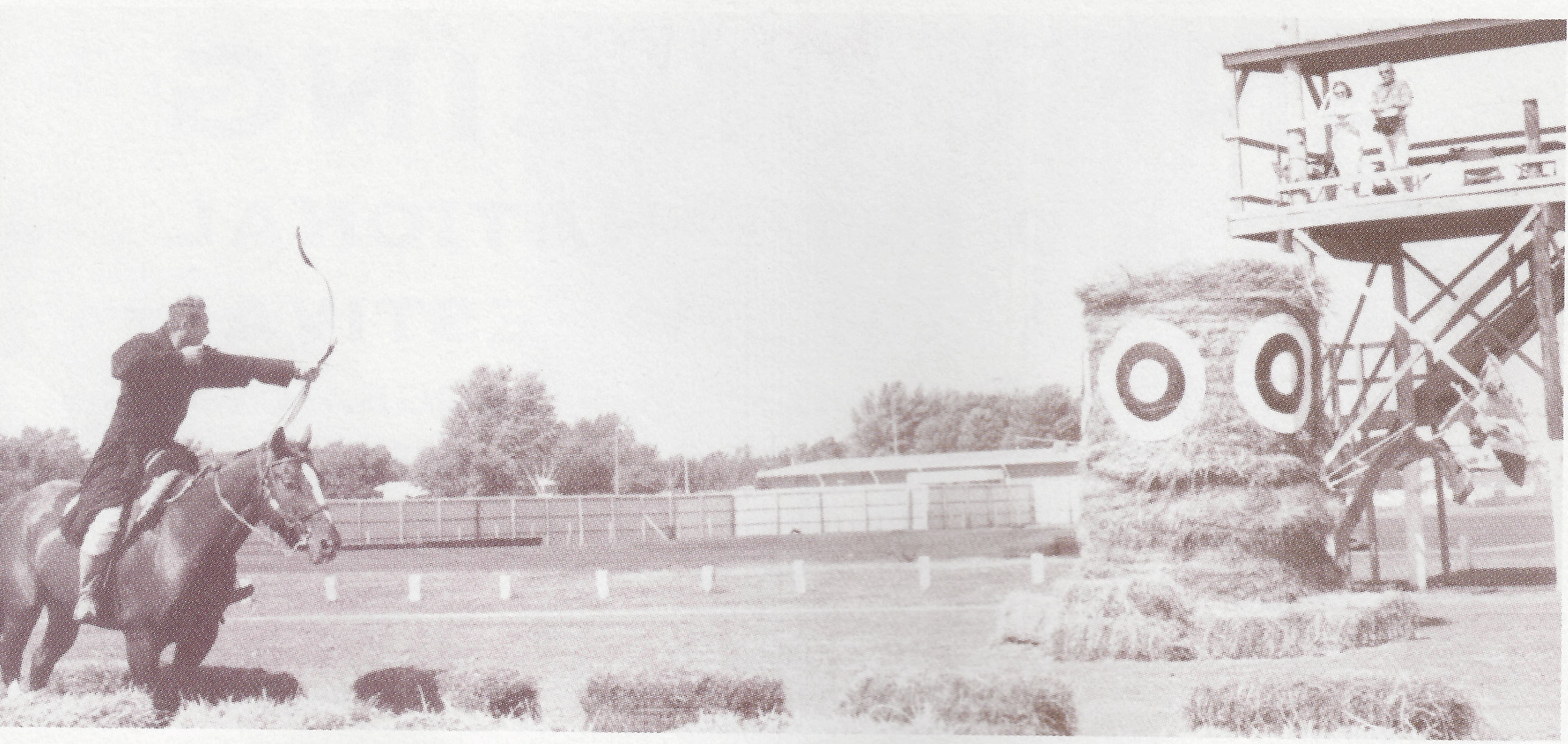
Finally, in mounted action, Dennis Hammer from Iowa on his lively Polish Arab, “lbn.”
WANTED: Twenty of the world’s top-mounted archers to squelch a terrorist band of horse archers in a remote country. Applicants must have the following characteristics and skills developed to the maximum…
How would you complete the ad? Or put yourself in the place of Magyar commander in the early 900’s when European citizens prayed. “Lord deliver us from the arrows of the Magyars.” Or go to the 1200s when the Mongols were thundering across the steppes. What were those commanders seeking in their mounted archers? Toughness, courage, self-control, keen senses, horsemanships, timing, flexibility, balance, speed, accuracy? In antiquity, all of these characteristics and more were hammered into the mounted archery from childhood. For any modern archer, some of these characteristics can be enhanced to some degree and with real benefit.
Our motivation for writing this article is twofold. First, it is an invitation and challenge to all persons potentially interested in horse archery to start horseless ground exercises. Secondly, these drills will enliven all archer’s practice routines and skills– whether hunter, competitor, or pleasure shooter. The objectives of the exercises include flexibility, balance, speed, and accuracy.
Our descriptions are based on closely observing the training exercises and performances of the world-class mounted archer. Kassai Lajos from Hungary. the first author has visited Kassai twice in Hungary and has worked with him during three different years here in the United States. Repeated viewing of these videos is intensely instructive, and his recent book opens up a whole new b=world of archery and the struggle of the human spirit. I personally find the exercises totally invigorating and they elevate archery to a whole new level of variety and excitement for me. The first author is not the most naturally coordinated person; if I can try it and get a lot out of it, then anybody can.
The second author is probably better wired by nature, but intensive long-term training and conditioning is the name of the game. Lukas has been training seriously for mounted archery both on the ground and on horseback for three years. He has learned under and with Kassai at all three of Kasssai’s appearances here in the United States and has been his primary assistant.
While many stiles may be used to do these exercises, these descriptions will largely reflect Kassai’s time-tested techniques. to shoot three arrows up to 30+ yards accurately in 6 seconds at a gallop does not allow for much error. Kassai has set a record of shooting 8 arrows in 11.3 seconds with reasonable accuracy on the ground. An important part of the archers challenge here is to learn to nock as quickly as possible with out looking at the arrow being nocked.
PREPARING THE EQUIPMENT
Kassai holds a sheaf of arrows on the right side of his bow in his bow hand, fletches up, and cock feathers turned toward him. I find it important to have arrows with snap nocks and prominent index ridges. The snap nocks need to fit the serving section of the string snugly so the arrow does not fall off in high action ground exercises or on horseback. The serving should cover the string 6 or more inches above the neck point so the arrow can be slid smoothly down to the nock point without hitting the bump where the serving beings. The serving needs to be applied carefully in order to be smooth and of a consistent diameter. The archer pulls an arrow out of the sheaf, directs the point between the string and the bow, and nocks.
If one prefers the thumb-ring release as Lukas does, then the procedure is different. A traditional Asian-type side quiver is used so that the arrows are not in the bow hand and in the way of the nocked arrow which is usually on the right side of the bow when using a thumb release. The motions in this style are very efficient (one smooth semicircular motion), but some are bothered by the sound of the slain arrows in the quiver when galloping. This is clearly the more common style of the Asian horse archers.
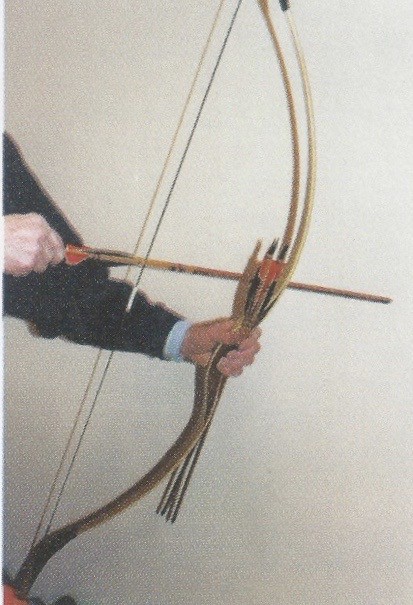
Detail of the string nock and the hand holding with arrows in position.
The thumb-ring shooter may also adopt Kassai’s method of holding a sheaf of arrows in the bow hand, but more toward the backside of the bow so the arrows do not interfere with the position of the nocked arrow on the right side of the bow. Grab and arrow by the nock, and instead of directing it between the string and the bow; it simply gets pulled down to the horizontal position and nocked (on the same side of the bow, which is the right side for most of the ring shooters). For the hunter, he or she usually does not want to carry an unshielded broadhead, but if one did anticipate several fast shots, this method would no jeopardize the archer’s bow hand, the string, or the bow. However, with field points, any of the methods described here are safe.
Kassai makes a nock point on his string by wrapping an adhesive tape of about t2 inches in width around the string until the cylinder of tape is 1/4-inch in thickness. The arrow rests on top of the wrapping, and no glove is required; this way the bare fingers have tactile and dexterity advantage for the rapid nocking, for the thumb release. option, the tape would be omitted and traditional nocking point should be attached on the string.
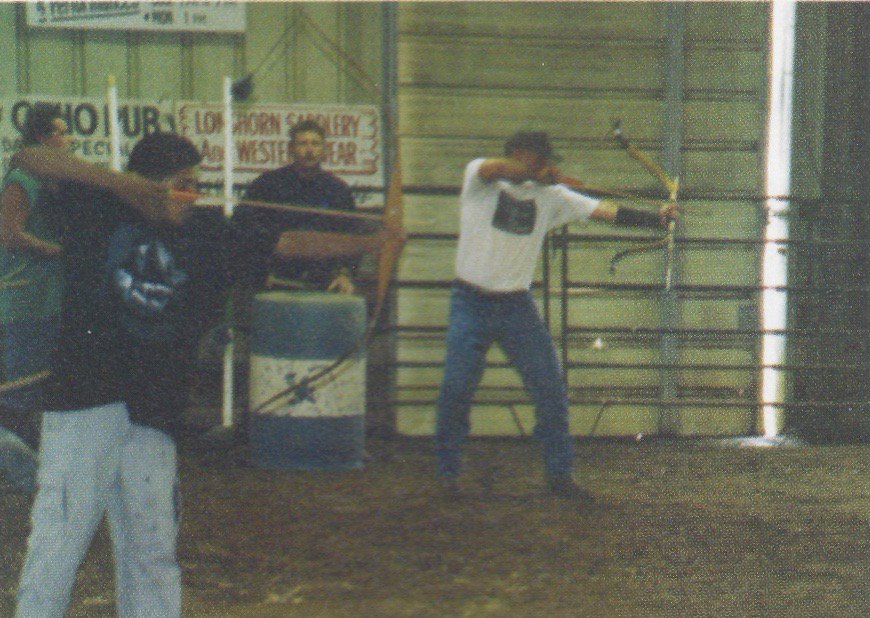
Shooting while standing still with a line of trainees behind the archer hurrying him or her along. Kassai on the barrel “drum.”
EXERCISES WHILE STANDING STILL
The first goal is to practice loading three arrows in teh bow hand properly, followed by successful nocking and shooting without ever looking at the nocking process. Do not set any time goals for several months. Concentrate on visualizing and performing a smooth pulling down of the arrow, a fluid pushing of the arrow point between the bow and the string, and a clean firm nock. All this time one’s eye is on the bull’s-eye and the arrow is sent to the dead center fo teh mark. Regardless of the actual placement of the arrow the archer is grateful for the joy of the shot. This can be done in the basement, garage, room, or hallway in the work kind of th weather. A standard absorbent target is the only other thing needed.
The push-pull style is deeply ingrained in most hunters, but Kassai’s style has three distinct steps for those who adopt it. First, one extends the bow hand fully toward the target with the string hand in perfect alignment, but without pulling the string. Second, the right hand comes to full draw. Third, the release occurs with strong exhaling and putting energy into the arrow. In the follow-through, the right hand is extended completely parallel to the ground and in line with the perfectly straight line of the released arrow.
The nocking practice does not even need to include shooting. One can simply nock and arrow, drop it to the floor, and nick another. I saw David Beshey, the festival manager, doing this at the Second International Horse Archery Festival.
The second goal is to start building up some speed. Keep visualizing each step with sharp focus until the process becomes pretty automatic. Expect each performance to be good, but be exceedingly patient. It is easy to mark off 15 or 20 seconds on your watch; that might be a good goal when you start to time yourself expecting perhaps two of the three arrows to be within a 9-inch paper plate at 10 to 15 years. Then one can gradually shape the performance demands of speed and distance to be greater. If performance happens to fall off, drop back temporarily to a lower level of demand and then build up again. Always build up speed gradually, and at the end of each session slow the pace back down.
For a very long-term reference, one might keep Kassai’s standardized mounted archery rules in mind. The course is a straight 90-meter track with a three-sided target at the 45- meter mark and placed 7 meters to the left side of the track. A single trial consists of galloping down the track and shooting three arrows at the three-sided target. An approach shot is directed at the first target while traversing the first third of the course. A second side shot is fired at the second target as one passes it at right angles this is the closes and easiest shot. Finally, one turns and shoots the parting shot in the last one-third of the course at the third face of the traget. Both the approach and parting shots average about t30 yards. A trial (three arrows) must be completed with in 16 seconds to count in cumulative scoring. And of course all this happens while riding the short undulating waves of the gallop.
At this point, variations in the standing-still exercises may be introduced. One may try standing 90 degrees turned away from one’s usual stance, and then 180 degrees. With reference to mounted applications, this is beginning preparation for the side shot and the backwards or parting shot. Sitting on a stool or log with those two orientations stimulates sitting o a horse to some extent. The objective is to pivot the torso at the waist without shifting the center of one’s weight, and with a minimum of twisting the legs. Twisting the legs may cue the horse , depending on the training, to change directions, and this is bad news on a straight track with the reins dropped and the horse on its own. Body flexibility and balance are in great demand here. The mounted archery horse should be retrained to be less sensitive to leg pressure when running the straight archery course.
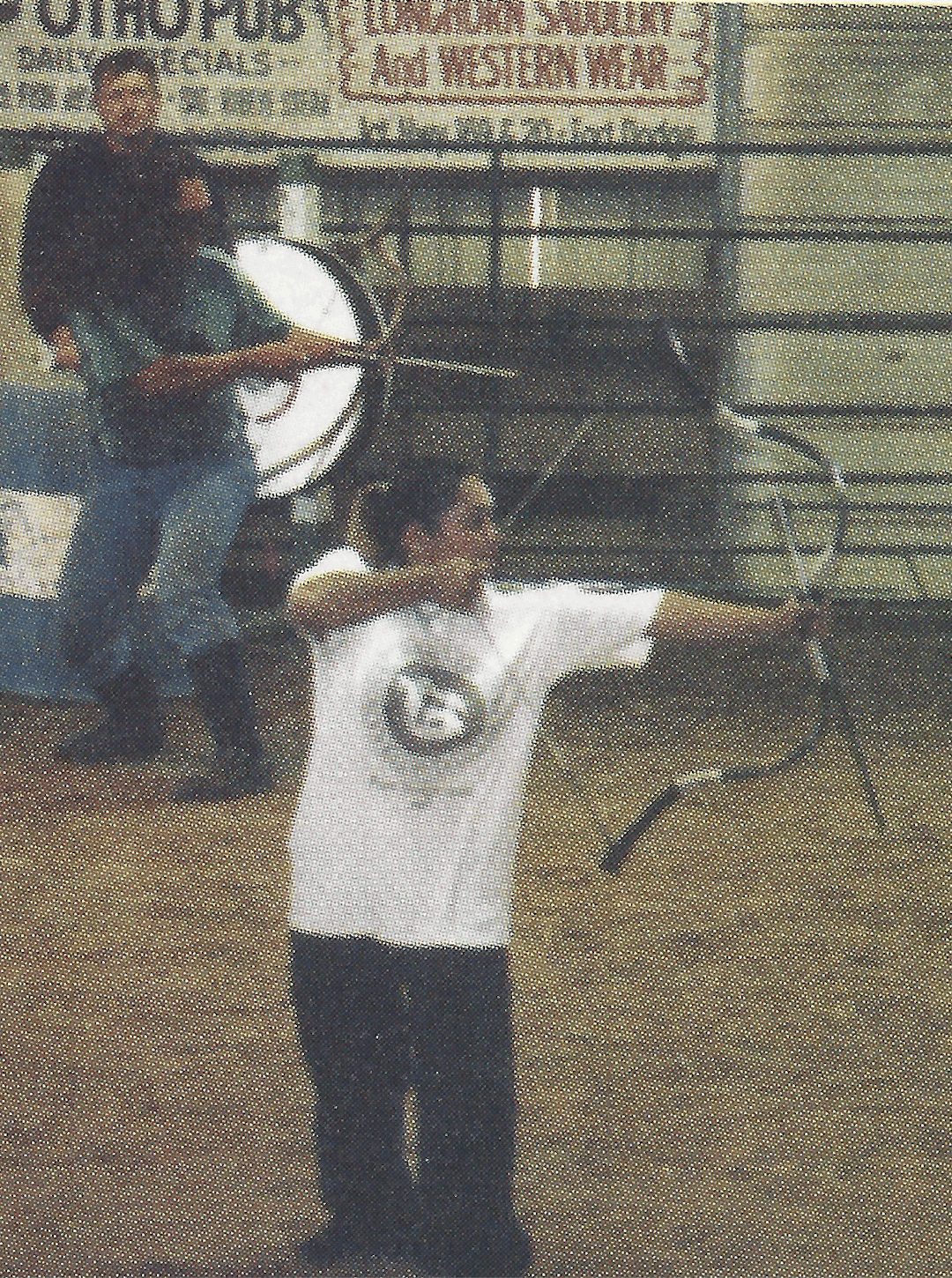
Shooting standing still but turned nearly 180 degrees away from the target.
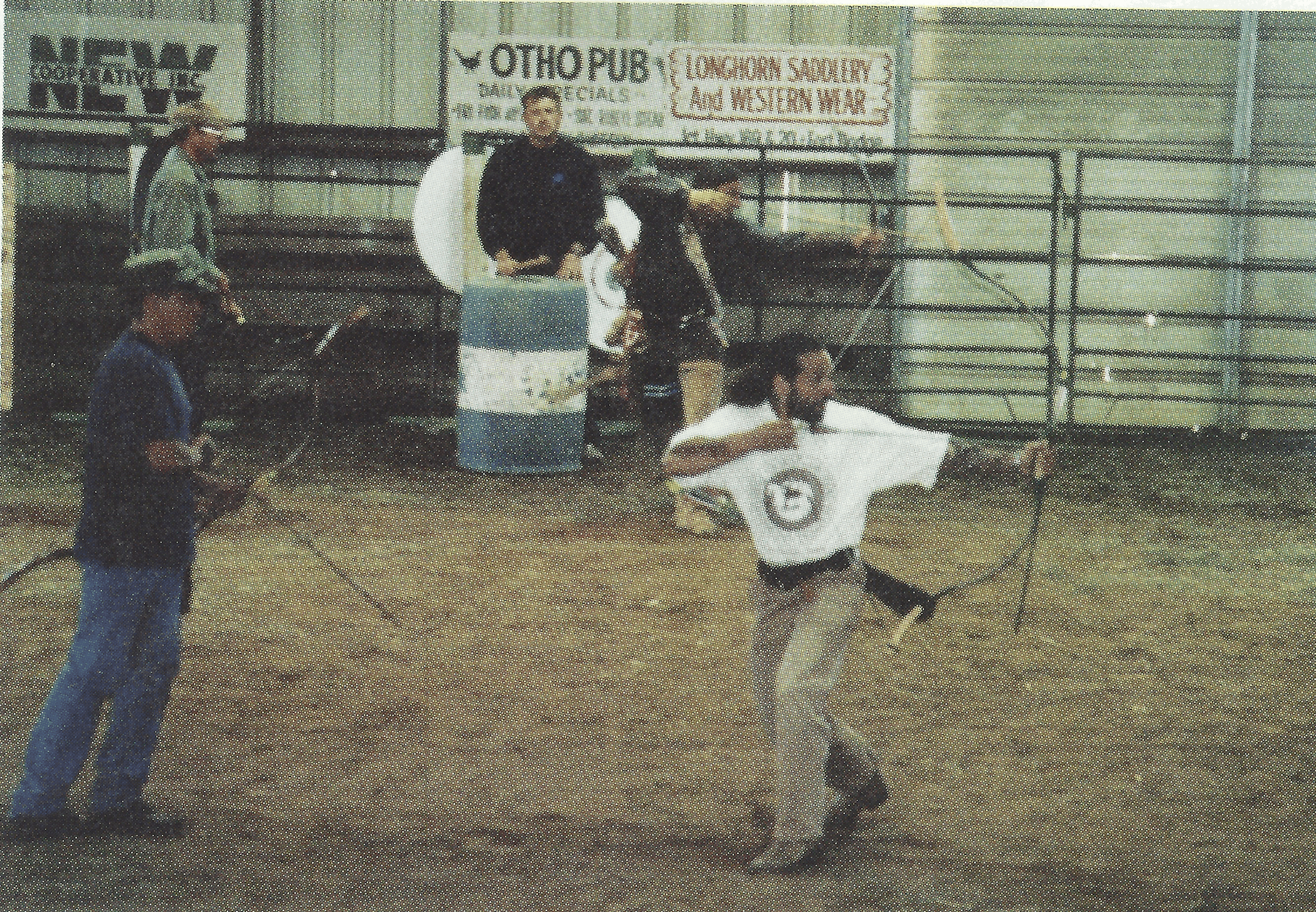
Run to position, pause as briefly as possible, and shoot as rapidly as possible.
Music with a strong beat can be added to the mix. Timing your shot to occur on the beat can sensitize the archer to the importance of teh rhythm and timing of the gallop. The shot is best taken at the highest point of each gallop sequence (least turbulent point). The reader can see Kassai in the photographs adding the beat to the drill by drumming a large plastic barrel.
EXERCISES WHILE IN MOTION
A nice simulation of shooting at the gallop is the squat exercise. Initiate rhythmic rapid firing of three arrows, one at a time, following a squat position. Fire the first arrow standing up, nock the second arrow during the downward movement of the squat and be at full draw as soon as one stands up (simulating the peak of the gallop). Repeat the pattern with the third arrow. This obviously introduces a lot of jiggling and motion and makes the exercise arider and more realistic if your eye is toward getting mounted. It will take years of this exercise to become smooth, rhythmic, and fast.
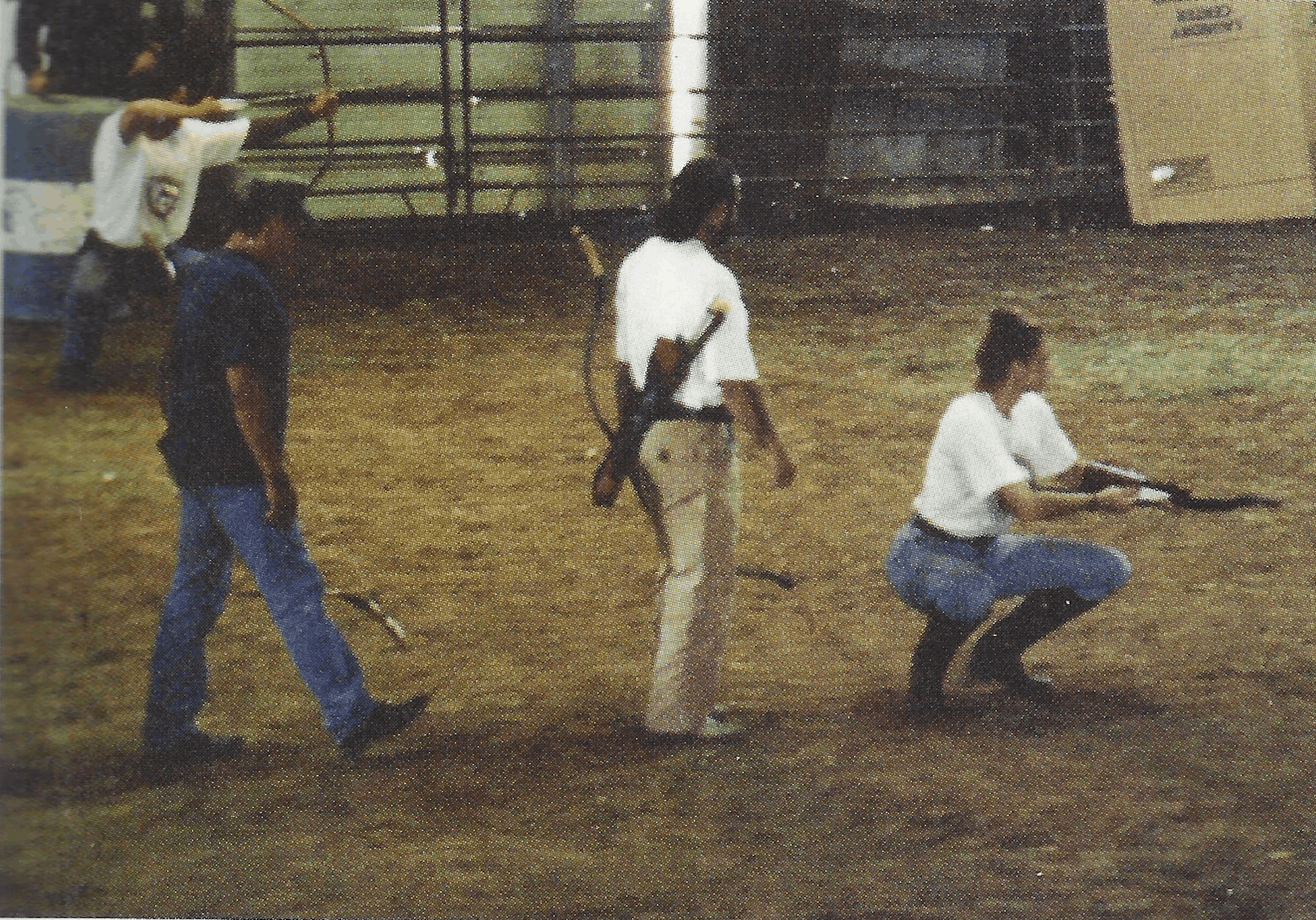
The squat action shot: nock while descending and be at full draw when fully standing.
The next set of variations, I have tried is to shoot while walking. Taking steps toward the target or backing steps away from the target are the easiest for starters. Once may pause briefly just before shooting when starting this exercise. The try walking at all angles toward and away from the target and at different distances, and at right angles as your skill unfolds. Rising to the next level of difficulty is to try the same variations at a jog. Running toward the target and shooting I spun, as well as running a circle and shooting from 12, 3, 6, an d9 o’clock positions.
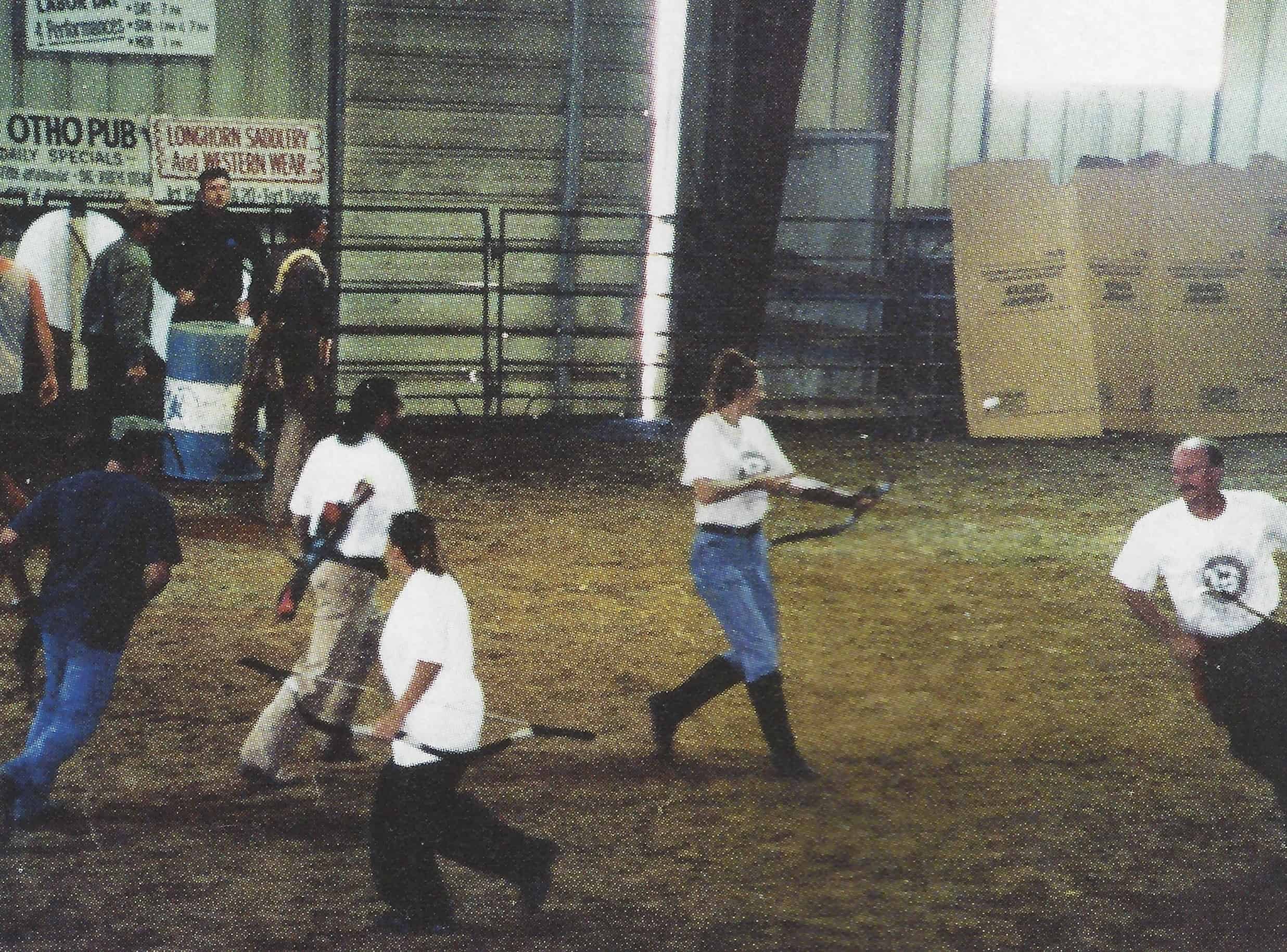
Run to position, turn 180 degrees, and shoot rapidly.
If there is the luxury of a group of archers or a club, then teams and running lines can be shot with all kinds of variations. yes, variations! Make your own. If a trace of boredom is sneaking into your shooting there is no end to the ways you can reintroduce excitement I guess there could be negative transfer to the hunt or especially the competitive archery range, but I doubt it. I have no systematic data one way or the other. we believe the exercises enhance our hunting skills, and will certainly assist ithe aspiring horse archer. One thing we know, it will add spice to a bland diet!
Now is the time to start mounted archery from the ground up.
Volume 10 Issue 3
More information about exercises and horse archery is available on the website of the International Horse Archery Festival, Inc. www.horsearchery.org, or by writing David Gray at gray@pathway.net or writing R. D. 1 Beechwood Road, New Wilmington, PA 16142. Lukas Novotnanymay be reached by email at salukibow@salukibow.com or P. O Box 438 Grand Rapids, Ohio 43522.